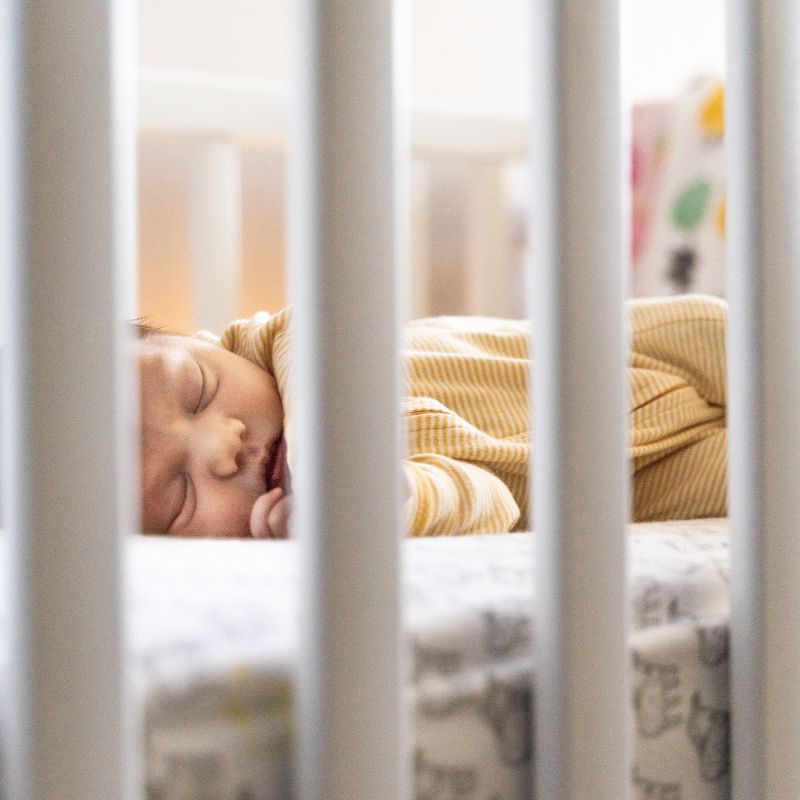Practicing safe sleep habits with your newborn can protect them from sudden infant death syndrome (SIDS) and other dangers. Although current research has not yet identified the actual cause of SIDS, we do know how to reduce the risk of it happening.
Normal newborn sleep patterns vary greatly from baby to baby, but in the first few days, the average newborn sleeps between 16 and 18 hours a day. By four weeks, they may be sleeping an average of about 14 hours, but the range is considerable. Most babies don’t stay asleep for longer than two to four hours at a time, day or night, for the first few weeks. So, while the baby gets a lot of sleep, the mother and/or the partner may not get quite as much.
Safest Places for Babies to Sleep
It is recommended that babies sleep in the same room as the mother and partner but in their own basinet or crib. The environment that they're in must also be free of smoke, as babies should never be exposed to secondhand smoke.
The Dangers of Leaving a Baby in a Car Seat to Sleep
It's important that parents not leave their infant asleep in their car seat. Often, when a baby falls asleep in the car, you may want to set the car seat down when you get inside and allow the baby to keep sleeping, but that is not the safest position for a new baby. Instead, babies should always be removed from the car seat and laid in their bed as soon as they get home. During the first several months, a small baby doesn't have very good head control. So, it's always possible for their head to slump forward slightly and not be noticed, potentially causing a lack of air exchange.
Short naps while in the car are usually fine, but the baby should not remain in the car seat for a long period. If you are driving for a long time, somebody should sit in the back seat with the baby to monitor them. The baby should always be removed from the car seat when the trip is over and placed in a position that's safer for them.
Types of Mattresses for Babies
A baby doesn't need a special type of mattress, just one that is firm, fits tightly against the sides of the crib and maintains its shape. A mattress that molds to one’s shape is not safe for a baby. The mattress should not be able to indent or conform to the shape of the baby's head when they are placed on the surface, as it can cause them to sink lower into the bedding and obstruct breathing. A pillow is not an appropriate mattress for a baby.
Co-Sleeping
A baby should always sleep in their own safe sleep space. While the American Academy of Pediatrics recommends that babies sleep in the same room as their mom/partner, they don't necessarily recommend that they co-sleep, meaning tucking a baby in close to you and having the baby sleep there during the night. Co-sleeping could potentially lead to oversleeping or suffocation. The term "co-sleeping" also applies to couches or recliners, where the baby could slip and be wedged between the cushions.
It's alright to bring an infant into bed to feed them, but once the baby has nursed and fallen asleep, or if you are starting to get sleepy, it's important to return that baby to their crib so they are in a safe, independent sleep environment.
Some families find that using a co-sleeper is helpful, as it allows the parent to remain close to their child during the night. A co-sleeper is a small bed that attaches to the side of the parent’s bed. While it provides a safe space for the child to sleep, it also allows the parent to easily shift the baby back and forth between the two beds. You can do the same thing with a bassinet or cradle by keeping it close to the bed so that the baby can be moved away from you during sleep.
Tips for a Safe Crib
All items should be kept out of a newborn’s crib. There should not be any loose blankets, bumper pads, or stuffed animals, as these could all potentially pose a risk of suffocation. There isn’t a specific age at which it is okay for a child to sleep with stuffed animals. It’s a different ballgame when babies become toddlers and can self-position and move their heads away and sit up.
Sleeping Positions
Babies should always be placed on their backs to sleep. Once they begin rolling, which is usually around four to six months, they should continue to be placed down on their back. But if they roll over during the night, it’s not necessary to turn them over again onto their back. Once a baby can self-position, they are usually okay to sleep in various positions.
Dressing Your Baby
Your baby feels like you do. If it’s a hot day and you’re wearing shorts and a tank top, you should not be putting your baby to bed in a blanket sleeper with extra covers. You would instead dress your baby in a light sleeper, possibly a onesie, lightly swaddled, or in a lightweight sleep sack. A baby overheating or being too warm is one of the risks for SIDS.
Although babies like the feeling of being swaddled and secure, once they start shifting around after the first few weeks, it is not as necessary to swaddle them as often. You don’t want to restrain them too much. There should always be room for the baby to move, as it’s important for their development that they can move their legs, hips, and arms.
Learn more by joining one of our childbirth and baby classes/support groups.


